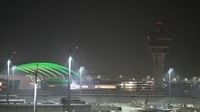Munich Airport, one of Germany’s busiest aviation hubs, found itself at the heart of a security storm last week after a string of mysterious drone sightings forced it to shut down twice in less than 24 hours. The unprecedented closures, which began on October 2, 2025, rippled across the region, stranding thousands of passengers, diverting flights to other European cities, and prompting authorities to scramble for high-tech solutions—including the deployment of a laser system designed to detect and deter rogue drones.
According to Bild and Euronews Next, the first reports of drone activity surfaced around 8:30 p.m. local time on October 2, when drones were spotted in the towns of Freising and Erding, just outside Munich Airport. The situation escalated quickly. Two hours after the initial sightings, drones were seen again, this time perilously close to the airport’s perimeter fence. In response, officials imposed a precautionary lockdown, canceling 17 flights and diverting 15 others to Stuttgart, Nuremberg, Vienna, and Frankfurt. As police launched what they described as “extensive search operations,” stranded passengers were offered camp beds, blankets, drinks, and snacks—a small comfort for those suddenly grounded by the unfolding drama.
The disruption was far from over. On October 3, German police reported two additional drone sightings, this time near the airport’s northern and southern runways, just before 11 p.m. The drones, however, vanished before they could be identified, leaving authorities with more questions than answers. The following morning, October 4, saw the chaos reach its peak: another wave of drone sightings led to the cancellation or diversion of 170 flights, as reported by both Bild and The Telegraph. The closures affected at least 6,500 passengers on Friday night into Saturday, while the previous night’s shutdown had already disrupted travel plans for nearly 3,000 more.
Munich’s troubles came at a particularly sensitive time. The city had just wrapped up its world-famous Oktoberfest celebrations, an event that annually draws millions of visitors. Simultaneously, Munich was hosting a government-held Migration Meeting, where, perhaps unsurprisingly, much of the discussion centered on the growing threat posed by drones and the urgent need for coordinated response strategies.
With the airport’s runways finally reopening at 7 a.m. on October 4, the immediate crisis appeared to have passed. But the larger questions remained unresolved. Who was behind the drone incursions? What was their motive? And could it happen again?
Authorities admitted they had no answers. As reported by The Independent, police were unable to provide any information about the perpetrators, and the drones themselves managed to evade identification each time they appeared. The incidents in Munich were not isolated. Over the previous three months, at least 11 European countries—including Lithuania, Latvia, Denmark, Norway, Romania, Poland, Estonia, Belgium, and France—had experienced similar drone incursions or disruptions to air traffic, according to The Telegraph and Euronews Next. In Belgium, drones were spotted over a military base, while in Oslo, Norway, a drone incident disrupted flights late last month.
The rash of incidents has fueled speculation about possible foreign involvement. European authorities have voiced concerns that Russia could be behind the overflights, especially given the ongoing tensions across the continent. However, as The Independent noted, Russian authorities have flatly denied any involvement, including in recent drone incidents in Denmark. Some experts have also pointed out that with the proliferation of commercial drones, almost anyone could be responsible, complicating efforts to assign blame or develop effective countermeasures.
In the face of mounting uncertainty, Germany has turned to technology for answers. As reported by Bild and corroborated by Euronews Next, a laser installation was deployed near Munich Airport in the immediate aftermath of the disruptions. The system, according to anonymous security sources cited by Bild, is designed to help authorities pinpoint the distance of drones from the airport—a crucial step in intercepting or disabling them before they can cause harm. While Germany’s Federal Police have not publicly confirmed the specifics of the laser’s capabilities, its presence underscores the seriousness with which officials are treating the drone threat.
The deployment of such technology is part of a broader, continent-wide push to strengthen defenses against drone incursions. At a meeting in Copenhagen in late September and early October, European leaders agreed to advance plans for a so-called “drone wall” along the European Union’s eastern border. The goal, as articulated by officials at the gathering, is to create an integrated system of detection and response, leveraging everything from radar and lasers to electronic jamming and physical barriers.
German Interior Minister Alexander Dobrindt, speaking in Saarbrücken during a ceremony marking the 35th anniversary of Germany’s reunification, highlighted the urgency of the situation. “We are in a race between drone threat and drone defense. We want to and must win this race,” Dobrindt declared, according to The Independent. He revealed that he and his European counterparts would be discussing a comprehensive “drone detection and defense plan” at a meeting in Munich over the weekend of October 4-5, underscoring the cross-border nature of the challenge.
For travelers and airport staff in Munich, the past week’s events were a stark reminder of the vulnerabilities inherent in modern air travel. The sight of camping beds set up for stranded passengers, the frustration of missed connections, and the uncertainty about when normal operations would resume—all these added a human dimension to what might otherwise be seen as a purely technical or security issue.
Yet, for all the disruption, the response from authorities was swift and determined. The rapid deployment of new technology, the coordination among police and airport officials, and the willingness of European leaders to confront the issue collectively all point to a growing recognition that drone threats are not going away anytime soon. As airports across Europe brace for the possibility of further incidents, the lesson from Munich is clear: vigilance, adaptability, and international cooperation will be key to keeping the skies safe.
While the identity of the drone operators remains a mystery, the events of early October 2025 have already left a mark on European aviation—and the race to outpace drone threats has only just begun.





